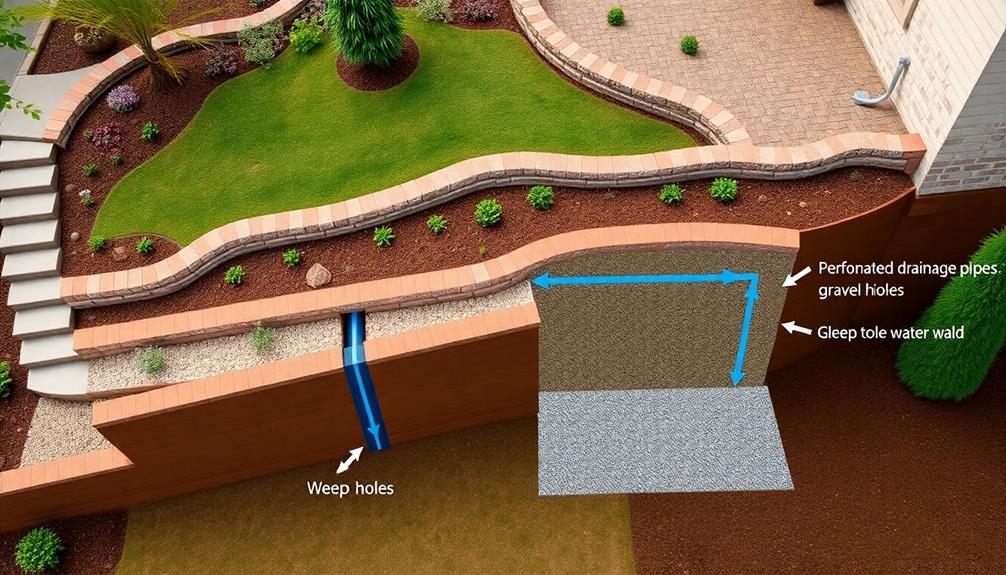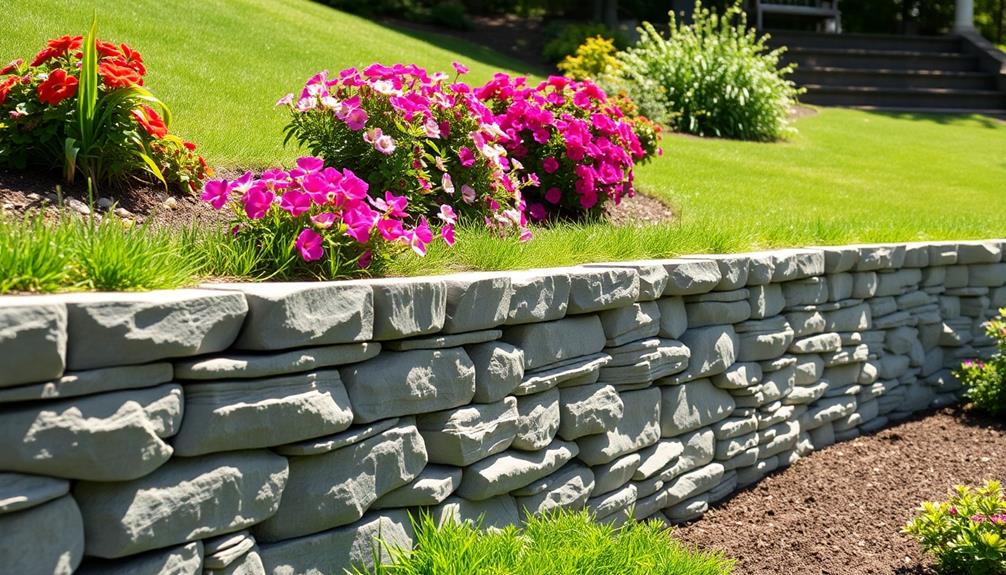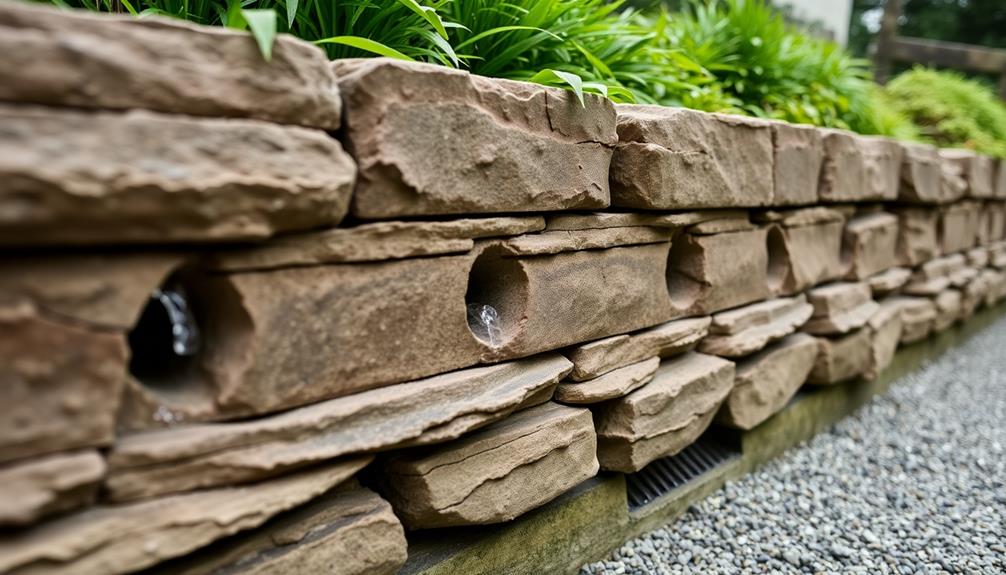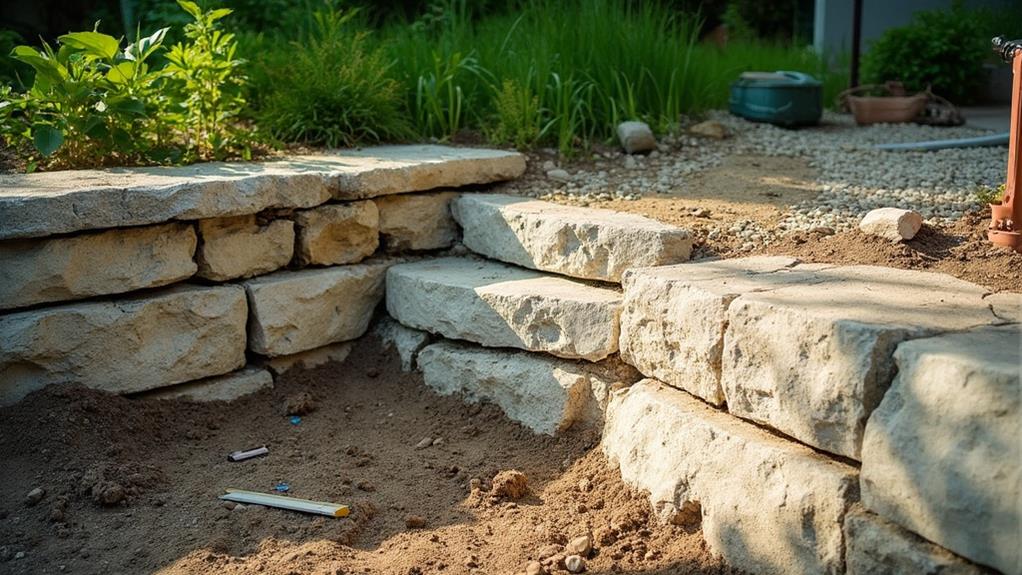Effective retaining wall maintenance encompasses pivotal practices that guarantee structural integrity and longevity. Proper drainage system installation, including well-graded gravel backfill layers, perforated drain pipes, and strategically placed weep holes, forms the foundation of optimal performance. Regular inspections, prompt repairs, and thorough cleaning are essential for preserving aesthetics and functionality. Implementing these best practices not only enhances landscape appeal but also contributes to improved soil stability and extended wall lifespan. By addressing potential issues early and maintaining consistent care, property owners can safeguard their investment and prevent costly repairs. Further exploration of these techniques reveals additional benefits and considerations for maintaining retaining walls.
Table of Contents
ToggleWalls Contractor Highlights
- Regularly inspect retaining walls for signs of damage, cracks, bulges, or shifting to address issues promptly.
- Maintain proper drainage systems, including cleaning weep holes and ensuring perforated pipes remain unobstructed.
- Remove vegetation growing on or near the wall to prevent root damage and soil destabilization.
- Apply waterproof sealants to protect the wall from moisture intrusion and weathering effects.
- Monitor and manage soil moisture levels behind the wall to prevent excessive hydrostatic pressure buildup.
Proper Drainage System Installation

A critical component of retaining wall maintenance is the installation of a proper drainage system, which involves several key elements. The foundation of effective drainage begins with carefully layered gravel backfill, which allows water to flow freely away from the wall structure.
This essential base is complemented by the strategic placement of perforated drain pipes and precisely positioned weep holes, working in concert to channel water away from the wall and prevent hydrostatic pressure buildup that could compromise its integrity. Additionally, incorporating these physical features helps guarantee the longevity and visual appeal of retaining walls, especially those crafted from materials like limestone or fieldstone, as addressed by experienced contractors who often recommend tailored solutions based on landscape requirements.
Gravel Backfill Layers
Proper installation of gravel backfill layers is essential for an effective drainage system behind retaining walls. These layers serve multiple critical functions, including facilitating water movement away from the wall structure, reducing hydrostatic pressure, and providing a stable foundation for the wall itself. To guarantee optimal performance, it is indispensable to implement a carefully planned layering system using appropriately sized materials.
The backfill should consist of well-graded, clean gravel with particle sizes ranging from 3/4 inch to 1 1/2 inches. This size range allows for adequate void space between particles, promoting efficient water flow while maintaining structural integrity. The gravel layers should be placed in compacted lifts of 6 to 8 inches, extending at least 12 inches behind the wall. Each lift must be thoroughly compacted using appropriate equipment to achieve optimal density and stability. It is paramount to avoid over-compaction, as this can lead to reduced drainage capacity. Additionally, a geotextile fabric should be installed between the native soil and gravel backfill to prevent soil migration and maintain the integrity of the drainage system over time.
Perforated Drain Pipes
Effective drainage systems for retaining walls rely heavily on the correct installation of perforated drain pipes. These essential components play a pivotal role in managing water accumulation behind the wall, preventing hydrostatic pressure buildup that can lead to structural instability.
When installing perforated drain pipes, it's critical to position them at the base of the wall, sloping away from the structure at a minimum grade of 1% to guarantee proper water flow. The pipes should be encased in a permeable fabric sock to prevent soil infiltration while allowing water to enter freely. This protective measure ensures the longevity and efficiency of the drainage system.
It's advisable to use pipes with a diameter of at least 4 inches to accommodate substantial water volumes during heavy rainfall events. The perforations should face downward to maximize water collection and minimize clogging. Additionally, incorporating cleanouts at strategic intervals along the pipe's length facilitates maintenance and allows for periodic inspection of the system's functionality.
Weep Holes Placement
Strategically placed weep holes are essential for ensuring proper drainage in retaining wall systems. These small openings, typically 3/8 to 1/2 inch in diameter, allow water to escape from behind the wall, preventing hydrostatic pressure buildup that could compromise structural integrity. Proper placement of weep holes is indispensable for maximizing their effectiveness and maintaining the longevity of the retaining wall.
When installing weep holes, it is imperative to position them at regular intervals along the base of the wall, typically every 4 to 6 feet. Additionally, incorporating weep holes at various heights throughout the wall structure can further enhance drainage capabilities. These higher placements are particularly beneficial in areas prone to heavy rainfall or where soil conditions may lead to increased water accumulation.
To ensure ideal functionality, weep holes should be slightly angled downward towards the exterior of the wall, facilitating efficient water flow. It is also advisable to use geotextile fabric or gravel filters behind the weep holes to prevent soil particles from clogging the openings while allowing water to pass through freely. Regular inspection and maintenance of weep holes are essential for preserving their effectiveness and safeguarding the retaining wall's structural stability.
Benefits

Proper maintenance of retaining walls yields numerous benefits that extend beyond mere structural integrity. Homeowners can expect to see an increase in their property value, as well-maintained retaining walls contribute to enhanced landscape aesthetics and demonstrate responsible land management.
For example, boulder walls not only provide customizable dimensions and location but also enhance the aesthetic appeal of the landscape. Additionally, careful upkeep guarantees improved soil stability and considerably prolongs the wall's lifespan, potentially saving property owners substantial costs in future repairs or replacements.
Increased Property Value
A well-maintained retaining wall can substantially boost a property's market value. By preserving the structural integrity of the landscape and enhancing its aesthetic appeal, a properly cared-for retaining wall becomes a valuable asset. Potential buyers often view well-maintained outdoor features as indicators of overall property upkeep, which can translate into higher offers and faster sales.
To maximize the value-adding potential of your retaining wall, consider these key maintenance practices:
- Regular inspections to identify and address minor issues before they escalate
- Prompt repairs of cracks, chips, or shifts in the wall's structure
- Consistent cleaning and removal of debris, moss, or vegetation growth
Incorporating these practices into your property maintenance routine demonstrates a commitment to preserving your investment. This dedication resonates with prospective buyers who seek homes that have been meticulously cared for. Additionally, a well-maintained retaining wall contributes to the overall curb appeal of your property, creating a positive first impression that can extensively influence a buyer's perception and willingness to invest. By prioritizing retaining wall maintenance, homeowners not only protect their property but also position themselves advantageously in the real estate market.
Enhanced Landscape Aesthetics
Beyond its impact on property value, a well-maintained retaining wall notably enhances landscape aesthetics. These structural elements serve as focal points in outdoor spaces, creating visual interest and defining distinct areas within a property. When properly cared for, retaining walls can seamlessly blend with the surrounding environment, complementing natural features and cultivating a harmonious outdoor atmosphere.
A meticulously maintained retaining wall contributes to the overall design coherence of a landscape. It can be adorned with cascading plants or climbing vines, transforming a utilitarian structure into a verdant, living tapestry. The interplay of textures between the wall's materials and carefully selected vegetation adds depth and dimension to the outdoor space.
Moreover, a well-kept retaining wall provides opportunities for creative landscaping solutions, such as terraced gardens or elevated planting beds, which can dramatically enhance the visual appeal of sloped terrain. By preserving the integrity of the wall's structure and appearance, property owners safeguard its continued function as an aesthetically pleasing element that elevates the entire landscape design, creating a more inviting and visually engaging outdoor environment for residents and visitors alike.
Improved Soil Stability
Retaining walls play an essential role in bolstering soil stability, offering significant benefits to property owners. These structures effectively manage soil erosion, prevent landslides, and create level surfaces on sloped terrain. By implementing proper retaining wall maintenance practices, homeowners can guarantee long-term soil stability and protect their investments.
Improved soil stability through retaining wall maintenance provides numerous advantages:
- Erosion control: Well-maintained retaining walls effectively mitigate soil erosion caused by water runoff, wind, and other environmental factors, preserving the integrity of the landscape.
- Increased property value: Stable soil conditions contribute to enhanced curb appeal and overall property value, making retaining wall maintenance a wise investment for homeowners.
- Structural support: Properly maintained retaining walls provide vital support for buildings, roads, and other structures built on or near slopes, ensuring their longevity and safety.
Regular inspection and maintenance of retaining walls are indispensable for identifying potential issues early on, such as cracks, bulges, or drainage problems. By addressing these concerns promptly, property owners can prevent more severe soil stability issues from developing, safeguarding their land and structures for years to come.
Extended Wall Lifespan
Through proper maintenance, the lifespan of retaining walls can be vastly extended, offering numerous benefits to property owners. This prolonged durability not only guarantees the continued structural integrity of the wall but also safeguards the investments made in landscaping and property development. By implementing a thorough maintenance regimen, homeowners and businesses alike can drastically reduce the need for costly repairs or premature replacements, ultimately saving both time and financial resources.
An extended wall lifespan contributes to the overall aesthetic appeal of the property, maintaining its visual harmony and preventing unsightly deterioration that could detract from the landscape's beauty. Additionally, a well-maintained retaining wall continues to perform its critical functions effectively, such as soil retention, erosion control, and flood prevention, for an extended period. This sustained functionality provides peace of mind to property owners, knowing that their land remains protected and stable. Furthermore, the longevity of a properly maintained retaining wall can potentially increase property value, as prospective buyers or appraisers recognize the care and attention given to this essential landscape feature.
Weep Hole Placement Considerations

Proper weep hole placement is vital for the effective drainage and longevity of retaining walls. When considering weep hole placement, engineers must account for proper spacing and intervals, correct size and shape, and protection from debris. The following table outlines key considerations for each of these factors:
| Factor | Importance | Considerations |
|---|---|---|
| Spacing | High | Wall height, soil type, water table |
| Size/Shape | Medium | Water volume, aesthetics, material |
| Debris Protection | High | Gravel backfill, filter fabric, covers |
Proper Spacing and Intervals
Weep holes play an essential role in the longevity and stability of retaining walls. Proper spacing and intervals of these drainage features are vital for effective water management and pressure relief. When designing weep hole placement, engineers and contractors must consider several factors to guarantee optimal performance.
To achieve proper spacing and intervals for weep holes, professionals should adhere to the following guidelines:
- Maintain a consistent horizontal spacing of 4 to 6 feet between weep holes, depending on soil conditions and wall height.
- Vertically stagger weep holes in alternating courses, typically every 32 to 48 inches.
- Increase weep hole density in areas prone to high water accumulation or hydrostatic pressure.
Correct Size and Shape
When considering weep hole placement, the correct size and shape of these drainage features are vital factors that significantly impact their effectiveness. The dimensions of weep holes must be carefully calculated to guarantee optimal water drainage while maintaining the structural integrity of the retaining wall. Typically, circular weep holes range from 3 to 4 inches in diameter, while rectangular openings may measure approximately 3 inches by 4 inches. These dimensions allow for sufficient water flow without compromising the wall's strength.
The shape of weep holes can vary, with circular and rectangular designs being the most common. Circular holes are often preferred for their ease of installation and reduced likelihood of clogging. Rectangular openings, on the other hand, may provide a larger surface area for drainage but require more precise cutting during installation.
When determining the appropriate size and shape, factors such as soil type, expected water volume, and wall height must be taken into account. It's essential to consult with a professional engineer or experienced contractor to ensure that the chosen weep hole configuration aligns with local building codes and site-specific requirements, ultimately contributing to the longevity and stability of your retaining wall.
Protection From Debris
A critical aspect of weep hole placement is ensuring adequate protection from debris. Properly shielded weep holes play a pivotal role in maintaining the structural integrity and longevity of retaining walls. By preventing the accumulation of soil, leaves, and other materials, these protective measures safeguard the wall's drainage system, allowing water to flow freely and reducing hydrostatic pressure.
To effectively protect weep holes from debris, consider implementing the following strategies:
- Install geotextile fabric around the weep holes to act as a filter, allowing water to pass through while blocking larger particles and preventing clogging.
- Utilize pre-fabricated weep hole covers or screens designed specifically to shield the openings from debris while maintaining proper drainage functionality.
- Implement a regular maintenance schedule to inspect and clean weep holes, removing any accumulated debris that may compromise their effectiveness.
Walls Contractor FAQ
How Often Should a Retaining Wall Be Inspected?
Retaining walls should be inspected at least annually, with more frequent checks after severe weather events or significant changes in soil conditions. Regular inspections help us identify and address potential issues early, ensuring the wall's longevity and our community's safety.
Can Plants or Trees Be Grown Near Retaining Walls?
Planting near retaining walls is possible, but caution is advised. Choose shallow-rooted plants and maintain a safe distance to prevent root damage. Consult a landscaping professional for guidance on suitable species and ideal placement for your wall's stability.
What Are Signs That a Retaining Wall Needs Repair?
Signs that a retaining wall needs repair include visible cracks, bulging or leaning, water seepage, and soil erosion behind the wall. Regular inspections are essential for our community's safety and property values. Let's work together to maintain our walls.
How Long Do Properly Maintained Retaining Walls Typically Last?
Properly maintained retaining walls can last several decades, typically 50-100 years, depending on materials and environmental factors. Regular inspections, prompt repairs, and proper drainage are essential for maximizing longevity. Our community values well-maintained structures that stand the test of time.
Are There Specific Materials Best Suited for Different Climate Conditions?
Indeed, climate-specific materials are essential for retaining walls. In wet climates, consider concrete or stone for durability. For dry areas, masonry or timber work well. Composite materials offer versatility across various conditions, ensuring longevity and performance for our structures.







